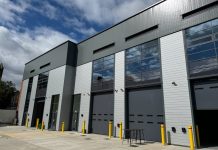A surge in speculative development currently underway in the UK logistics and industrial market will help replenish an undersupplied market, according to research from Cushman & Wakefield.
Eight million sq ft of speculative development was underway across 44 buildings of 50,000 sq ft and above at the end of 2018. This followed a post-global financial crisis peak of 9.7 million sq ft in the third quarter of the year. The appetite for speculative development is being partly explained by the prospects of letting space out quickly. In fact, the average void period for speculatively built space fell to just nine months in the final quarter of 2018 – the lowest level since Cushman & Wakefield began tracking this data in 2009.
The report, which assesses how the current volume of construction might impact the UK logistics property market, revealed that low vacancies (around 5%), scarcity of land in prime locations and a restrictive planning regime are likely to prevent any oversupply whilst pent-up demand for Grade A space will continue to fuel rental growth.
E-commerce occupiers are driving demand. With online sales doubling every five years and forecast to increase to 25% of total UK retail sales, demand from this sector is expected to remain strong for the foreseeable future. It is also affecting the type of space being delivered with development of extra-large units accelerating since 2016 in response to expanding e-commerce networks which require multiple eFulfillment centres. Five buildings over 400,000 sq ft are currently under construction across the UK, more than any calendar year since 2009.
Cushman & Wakefield estimates that at current take-up rates, vacant newly built space will reach 14 million sq ft by the end of 2019, still 30% below the peak of over 20 million sq ft registered in 2009. Furthermore, the market has become increasingly transparent, and developers have greater visibility over what is being built and where. When also factoring in the increasingly shorter construction lead times, they can respond quicker to changing market conditions.
The bulk of speculative construction is concentrated in three regions: London and the South East/East (31%), the Midlands (35%) and North West (13%). Development is primarily in established locations however last year saw a number of emerging ‘clusters’ in non-core locations including the M6 north of Birmingham, Nottingham, Banbury, Aylesbury and Bedford.
Bruno Berretta, UK Logistics & Industrial Research & Insight, Cushman & Wakefield, said: “The supply and demand indicators we have reviewed suggest that despite the surge in speculative development, the risk of oversupply is unlikely for now. In absence of a major economic shock, positive demand fundamentals, which include e-commerce combined with remaining supply constraints, will continue to fuel rental growth which is likely to be localised in prime locations.”
Cushman & Wakefield’s analysis of the second-hand space market also revealed that occupiers seeking larger units could benefit from several traditional retailers releasing large, good quality stock on to the market due to supply chain restructuring or bankruptcy.
Simon Lloyd, Partner, National Logistics & Industrial at Cushman & Wakefield in Birmingham said: “Whilst there will continue to be demand from occupiers for built to suit solutions, particularly in the manufacturing sector, the availability of speculative buildings is important in this dynamic market sector. The immediacy of a building solution for an occupier means they can focus on the operational aspects of their requirements, and therefore satisfy the demands of their customers. The current supply of new buildings does not represent many months’ take-up, and consequently occupiers will still need to focus on building solutions at an early stage.
He added: “In the Midlands, there has been an increasing amount of speculative development, not only in larger buildings such as Panattoni’s 450,000 sq ft building at Four Ashes, but also mid-range buildings by a range of developers such as St Modwen, A&J Mucklow, IM Properties and Barberry. This supply will appeal to occupiers as they continue to identify the best and most flexible buildings to suit their businesses.”





















